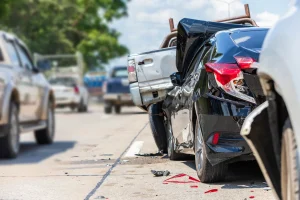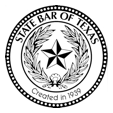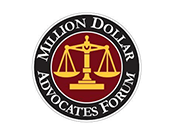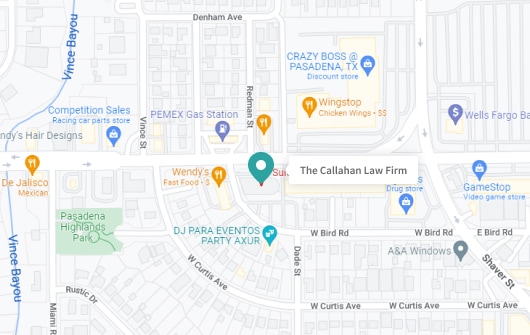Determining Fault in a Multi-Car Accident in Texas: A Comprehensive Guide

Multi-car accidents are a frequest occurrence in Texas. These crashes involve multiple vehciles, multiple drivers, varying degrees of damage, and intricate legal implications. All of these factors make determining the cause of these types of crashes complex and often difficult. Understanding who is at fault in such scenarios is crucial for insurance claims and any other legal proceedings. If you’re unable to determine who is at fault, you won’t be able to recover the compensation you need to focus on your recovery.
With so much at stake, having an experienced personal injury attorney on your side is highly recommended after a major pile-up. They will know how to conduct a thorough investigation, demonstrate the other driver’s negligence, and fight for the compensation you deserve. Don’t leave your financial recovery to chance – contact The Callahan Law Firm today to schedule a no-cost consultation.
Factors Influencing Fault in a Multi-Car Accident
Determining fault in a multi-car accident involves assessing the negligence of each driver or party involved. Negligence refers to a person’s failure to act with reasonable care, leading to the accident and resulting injuries or damages. To prove negligence in Texas, four elements must be established:
Duty of care: Drivers have a duty to drive safely and avoid endangering others on the road. This includes obeying traffic laws, being alert, driving at safe speeds, and operating the vehicle properly.
Breach of duty: When a driver fails to exercise reasonable care, they have breached their duty of care. Examples include speeding, distraction, impairment, or recklessness behind the wheel.
Causation: The driver’s negligent actions must directly cause the accident, such as running a red light and crashing into another vehicle.
Damages: The accident must lead to actual losses or injuries, such as vehicle damage, medical bills, lost income, or pain and suffering. Without damages, there is no viable negligence claim.
In multi-car accidents, liability often falls on the driver who caused the initial collision through their negligent actions. However, other drivers involved may share fault if they also acted negligently in any way leading up to the crash.
Third-party liability
Third parties can also be held liable in some cases. For example, if a vehicle defect or failure contributed to the accident, the manufacturer may be negligent. Commercial trucking or transportation companies can also be sued for negligence if their driver caused the crash. These avenues should be explored when building a personal injury claim after a complex multi-car accident.
Investigating Fault in a Multi-Car Accident
Determining who is at fault in a multi-car accident requires a thorough investigation, which often starts at the scene and extends into a detailed analysis. Here are some key points to consider in this process:
Role of the Police Report
The police report plays a foundational role in the assessment of any multi-car accident by documenting the immediate details and observations from the scene.
The report will include factual information such as the date, time, and location of the accident, descriptions of the vehicles involved, visible damages, and road conditions.
Officers may also include their professional assessment or opinion regarding how the accident occurred and any contributing factors, such as speeding or failure to yield.
Limitations of Police Reports
Police reports are valuable, but they have limitations. They may not capture the full scope of the accident if the scene was altered before their arrival or if some details were not immediately observable. Reports can sometimes contain inaccuracies or lack detail on the mechanics of the accident, which can affect the fault determination.
Gathering additional evidence
To build a comprehensive understanding of the accident, additional evidence beyond the police report is necessary.
Crash Reconstructions
In particularly serious and complex cases, specialists in accident reconstruction can be brought in to analyze how the accident occurred. This involves using the physical evidence from the scene, such as skid marks and vehicle positions, to recreate the sequence of events leading up to the crash.
Eyewitness Testimonies
Statements from witnesses can provide crucial perspectives that are not captured in the police report. Witnesses might offer details on actions like sudden lane changes or the behavior of the drivers before the accident.
Utilizing Electronic Data
Modern vehicles often come equipped with electronic data recorders (EDRs), similar to “black boxes,” that record various data points at the time of an accident, such as speed, brake application, and steering angle. This data can be vital in understanding the actions taken by drivers just before a collision.
The combination of these investigative tools helps in piecing together a precise picture of the events and determining fault accurately in a multi-car accident.
Comparative Negligence Law in Texas
Texas follows a modified comparative negligence rule when determining fault and liability in multi-vehicle accidents. This means that an injured party can collect damages from other at-fault drivers based on the percentage of fault determined for each party.
However, if the injured party’s percentage of fault is greater than 50%, they are barred from recovering any damages. For example, if a plaintiff is found to be 30% responsible for an accident and the total damages are $100,000, they can only recover 70% of the damages, or $70,000. If the plaintiff is 51% responsible, they cannot recover any damages at all.
Joint and Several Liability
In Texas, joint and several liability allows a plaintiff to recover the entire amount of judgment from any one of multiple defendants if that particular defendant is responsible for at least 50% of the fault. This is important in cases where other defendants are unable to pay their share of the damages due to insolvency or other reasons.
Understanding these nuances of Texas law is vital for anyone involved in a multi-party accident, highlighting the importance of detailed investigations and legal representation to determine fault and recover damages accurately.
Challenges in Multi-Car Accident Insurance Claims
Navigating insurance claims after a multi-car accident can be particularly challenging due to the complexity of the incidents and the various policies involved. Understanding these challenges is crucial for anyone involved in such accidents.
Multiple Injured Parties and Limited Coverage
When multiple parties are injured in an accident, the total number of claims may exceed the policy limits of the at-fault driver’s insurance. This often results in each injured party receiving less compensation than might be necessary to fully cover their damages, as the available funds may be divided among all claimants.
Strategies Used by Insurance Companies to Minimize Settlements
Insurance companies may employ various strategies to reduce the amount they pay out in multi-car accidents. These can include disputing the extent of injuries, questioning the necessity of medical treatments, and attributing more fault to other parties, including sometimes the claimants themselves, to lower their financial liability.
Importance of Personal Injury Protection (PIP) and Uninsured/Underinsured Motorist (UM/UIM) Coverage
Having adequate personal injury protection (PIP) and UM/UIM coverage can significantly impact the financial recovery process following a multi-car accident.
PIP is an extension of car insurance available in some states that covers medical expenses and lost wages, regardless of who is at fault in the accident. This coverage is particularly beneficial in multi-car accidents, as it provides immediate financial relief without the need to establish fault, which can be a prolonged process in complex accidents.
The importance of possessing uninsured or underinsured motorist coverage is also worth noting, as it provides critical financial protection when at-fault drivers lack sufficient insurance to cover all damages
Understanding these insurance dynamics and having strong coverage can help alleviate some of the financial burdens that may arise for individuals involved in these types of accidents.

Seeking Legal Assistance for Multi-Car Accidents
Navigating the aftermath of a multi-car accident can be complex, making the guidance of a qualified car accident lawyer invaluable. Here’s how The Callahan Law Firm can help you in this situation:
No-Cost Initial Consultation: Initial consultations give potential clients the opportunity to discuss the specifics of their case, receive personalized legal advice, and understand the best steps forward.
Guidance in Determining Fault and Pursuing Compensation: Lawyers provide essential insights into establishing fault, identifying liable parties, and formulating strategies to maximize compensation.
Negotiating Fair Settlements and Representing Clients in Court: Skilled in negotiations, a lawyer can deal effectively with insurers and other lawyers and, if necessary, represent your interests in court to ensure a fair resolution.
Navigating the aftermath of a multi-car accident requires a deep understanding of legal nuances and a strategic approach to handling claims and compensation. The complexities of such cases, from determining fault to negotiating settlements, highlight the necessity of professional legal guidance. The Callahan Law Firm is here to help.
Securing Your Rights After a Multi-Car Accident – Contact The Callahan Law Firm
Understanding the complexities and challenges inherent in multi-car accidents is crucial. From determining fault among multiple parties to dealing with insurance claims that may exceed policy limits, the process can be overwhelming. Having the right legal support is essential in navigating difficult legal claims, negotiations, and potential court proceedings. Don’t try to handle the situation on your own. Contact The Callahan Law Firm to schedule a no-cost consultation with a car accident lawyer.
FAQ
Whose fault is it when two cars merge into the same lane?
In cases where two cars merge into the same lane and collide, fault is usually determined by who had the right of way and which driver was more negligent.
Whose insurance pays for a multi-car accident in Texas?
In Texas, which follows a fault-based system, the insurance of the driver who is found to be primarily at fault for the accident will typically cover damages. If multiple drivers share fault, each may need to pay a portion corresponding to their degree of fault.
Who is at fault in a three-car rear-end collision in Texas?
In a typical three-car rear-end collision, the driver who hits the first car and causes it to hit the third car is often primarily at fault. However, each case can vary.
When lanes merge, who has the right of way?
Generally, when lanes merge, the vehicle in the continuing lane (the lane that is not ending) has the right of way. Vehicles in the lane that ends should yield and merge safely without disrupting the flow of traffic in the continuing lane.

Michael S Callahan is an attorney and founder of The Callahan Law Firm. He focuses his practice on representing individuals and families in personal injury cases involving motor vehicle and truck accidents, workplace accidents and defective products. With over 25 years of experience, he is dedicated to fighting on behalf of people whose lives have been forever altered by the negligence and carelessness of corporations and individuals. Originally trained as a mechanical engineer, Michael has been practicing law and fighting for justice for those who need it most since 1994. He is board-certified in Personal Injury Trial Law by the Texas Board of Legal Specialization and a member of various esteemed legal associations. Outside of work, Michael enjoys spending quality time with his family, outdoor activities, and continually striving to improve as a trial lawyer and human being.











